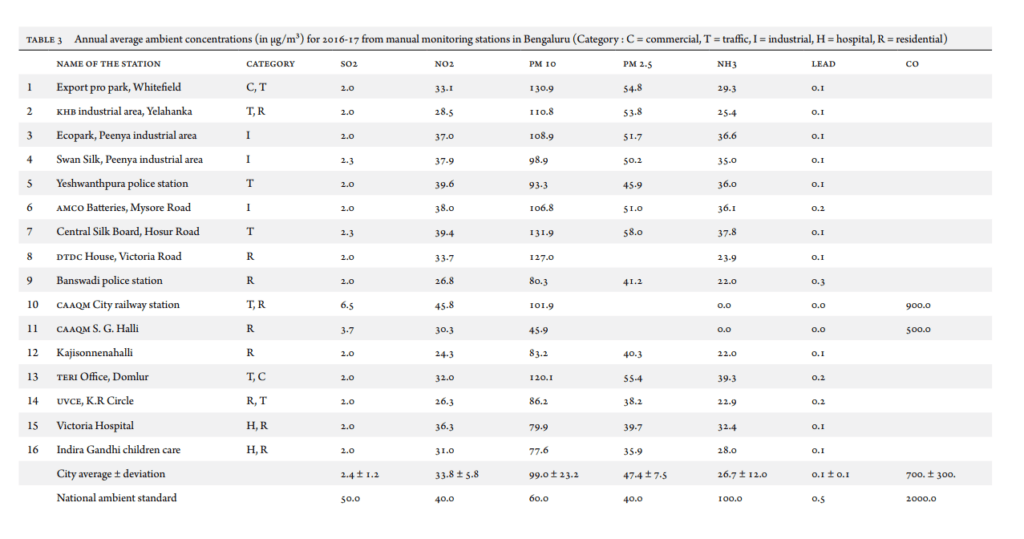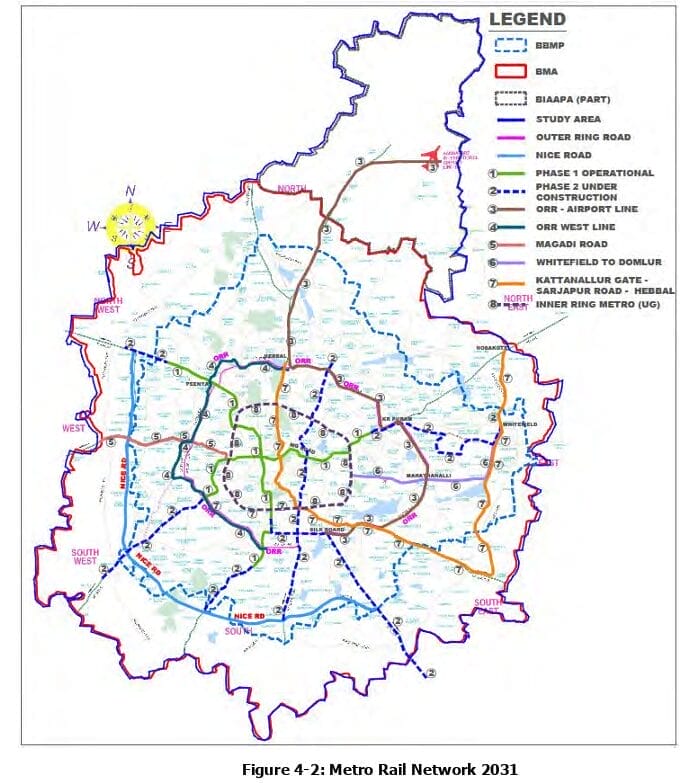Traffic congestion and mobility are among Bengaluru’s topmost concerns today. In the run-up to the elections, as the spotlight turns on how the city’s sitting MPs have performed over the last five years, their actions and stance on this issue certainly deserve some scrutiny. How have they engaged with the issue? Did they propose any solutions?
The major traffic & mobility issues
In 2019, Bengaluru recorded the second highest number of vehicle, with over 80 lakh. Nearly 84% of households have motor vehicles.
Lack of first and last mile connectivity, reduced bus ridership, under-completion of metro connectivity across the city, lack of cycling paths are some of the main reasons why people choose private vehicles over public transport.
Inadequate mobility not only leads to congestion but also contributes to air pollution, potentially causing an estimate of 2,500 deaths in the city in 2024. The main pollutant, PM2.5 concentration is 3.9 times the World Health Organization (WHO) annual air quality guideline value. These alarming statistics highlight the need for improved mobility in the city.

What MPs suggested
Tejasvi Surya
In Lok Sabha Matters Under (Rule 377) Debate, 2019, Tejasvi Surya, Member of Parliament, Bangalore South, spoke about the need to improve intra city mobility infrastructure in the city. “For long, we have focused on the mobility of vehicles instead of working on the mobility of people. Widening roads and flyovers ease up traffic congestion but indirectly promote more private vehicles getting onto the road. The solution would be to generate alternative means of public transport but one such facilitator – the suburban rail network – has not been implemented in Bengaluru.”
He observed that the existing network of 180 kms of rail line and 50 plus operational stations could be used for intra-city mobility, benefitting millions of daily wage workers, students, IT employees, among others.
He also wrote in a LinkedIn post about developing Bengaluru Cantonment Railway Station, a key part of the Bengaluru Suburban Rail Project’s Whitefield to Kengeri line (Corridor 3).
On X, he hailed the plans for a Rs. 2,500 crore mega rail terminal in Devanahalli.
However, the fact remains that the metro has been delayed in Bangalore South by a year, and that the suburban train is yet to be made a reality, as pointed out by co-founder of Political Shakti, Tara Krishnaswamy on X.
Tejasvi Surya had also written to Chief Minister Siddaramaiah to reconsider the ban on carpooling as this would lead to worse traffic congestion. “Ride-sharing and carpooling are immediate and suitable remedies to ease the mobility crisis to a certain extent,” he said. His support for carpooling did not go down well with auto and cab drivers, who protested against it.
Last year, he asked Deputy Chief Minister DK Shivakumar to invest in mass rapid transport systems instead of tunnel roads.
PC Mohan
PC Mohan, Member of Parliament, Bengaluru Central, inquired about the current status of the suburban railway development in the city, details of funds released and update on Phase 2 of suburban rail. Minister of Railways, Communications and Electronics & Information Technology, responded that the Bengaluru Suburban Railway Project has four corridors:
- Corridor-1: KSR Bengaluru City – Devanahalli (41.4 Km)
- Corridor-2: Baiyyapanahalli – Chikkabanawara (25.01 Km)
- Corridor-3: Kengeri – Whitefield (35.52 Km)
- Corridor-4: Heelalige – Rajankunte (46.25 Km).
Work on Corridor 2 has begun, while the other corridors are awaiting tender and survey completion.
In 2022, PC Mohan wrote to the Transport Minister, Nitin Gadkari, about the traffic congestion from KR Puram to Hoskote.
DK Suresh
DK Suresh, Member of Parliament, Bengaluru Rural, asked the Minister of Railways, Communications and Electronics & Information Technology to reveal whether South Western Railway (SWR) has proposed a 287-km circular rail network in the outskirts of Bengaluru to decongest the city’s traffic, to which the Minister responded that the DPR is yet to be completed.

In five years, none of the MPs have utilised their MPLADS funds on traffic and mobility in Bengaluru.
Initiatives to improve mobility in the city
The Bengaluru Metropolitan Land Transport Authority Bill (BMLTA), 2022 was set up with the intent of planning and monitoring transport as well as coordinating between transport agencies, urban local bodies, and infrastructure development agencies in the city. But it is yet to be implemented. Demands for BMLTA’s establishment have been put forth by experts and citizens.
Innovative ideas have been discussed to enhance mobility, such as transforming public transport spaces into multifunctional utility hubs. This was suggested at the second edition of Deccan Herald‘s Bengaluru 2040 Summit. A person returning from the office should be able to do grocery shopping at the metro itself, said Bengaluru Metro Rail Corporation Limited Managing Director Anjum Parwez. “The idea is to reduce the traffic and movement of people on the roads,” he added.
High tech solutions have been implemented to tackle traffic. The city traffic police has introduced Actionable intelligence for Sustainable Traffic Management (ASTraM), an intelligent traffic engine to enhance awareness and enable data driven decisions for effective traffic management. The system alerts congestion, incident reporting via BOT mobile applications, dashboard analytics and special event management.
Read more: Pedals of change: Chennai’s shift to a sustainable mobility future
Directorate of Urban Land Transport (DULT) Karnataka prepared a Comprehensive Mobility Plan for Bengaluru in 2020, which surveys the city’s mobility and provides possible solutions and policies. As per their survey, major traffic enters the city through Hosur road (NH-7) and most junctions have exceeded their capacity of traffic volume. They have also come up with 10 strategies to improve mobility and transport in the city.

11 high demand corridors have been identified as priority corridors (202 kms) with exclusive lanes for public transport buses. The bus fleet size is proposed to be expanded to 16,582 by 2031. 40 new depots and TTMC/Bus Terminals have been identified within the newly planned areas of the city. The Bus Rapid Transit System (BRTS) or Metrolite system has been suggested for the Peripheral Ring Road (PRR) and NICE Road.
Foot over Bridges are proposed at 154 locations to facilitate safe and efficient movement of pedestrians. 974 kms of footpath are proposed to be constructed with 600 kms of cycle track and 103 kms of Tender Sure Roads. Eight streets which have significant pedestrian and commercial establishments are recommended to be declared as pedestrian only streets on Saturday, Sunday, other holidays and special days.

The utilisation of existing railway networks in the city for running robust suburban rail services connecting the peripheral areas and settlements around Bengaluru is being explored. A Detailed Planning Report (DPR) for suburban rail system for Bengaluru has been undertaken by the Indian Railways.
With about 7.5 lakh ridership per day, Namma Metro functions on two operational lines (Phase 1, Phase 2) currently:
- Line-1 – Purple Line: Challaghatta – Whitefield (Kadugodi) (42.17 km, 37 stations)
- Line-2 – Green Line: Nagasandra – Silk Institute (30 km, 29 stations)
Under construction lines: (Phase 2, Phase 2A, Phase 2B):
- Line-2 – Green Line: Silk Institute – Anjanapura Depot (0.50 km, 0 stations)
- Line-2 – Green Line: Hesaraghatta Cross (erst. Nagasandra) – Madavar (erst. BIEC) (3.031 km, 3 stations)
- Line-3 – Yellow Line: RV Road – Bommasandra (19.143 km, 16 stations)
- Line-4 – Pink Line: Gottigere (Kalena Agrahara) – Nagawara (21.386 km, 18 stations)
- Line-5 – Blue Line: Central Silkboard – KR Puram (18.236 km, 13 stations, “ORR Line”)
- Line-5 – Blue Line: KR Puram – Hebbal – KIAL Terminals (37 km, 17 stations, “Airport Line”)
105.5 km of proposed routes in Phase 3 yet to be finalized.
Karnataka Minister MB Patil said that the Bengaluru Suburban Railway Project (BSRP) is expected to be completed by December 2027. However, progress on BSRP has been slow so far.
Most of the projects planned in the Comprehensive Mobility Plan for Bengaluru, 2020 are aimed at being completed by 2031. However, the data collection, analysis, funding, approvals haven’t still not been discussed, and the lack of a timeline only keeps these plans restricted to paper with no implementation on the ground. Though the talks, initiatives and projects seem to connect the city with feasible public transport and mobility infrastructure, progress is slow.
Campaigns to promote public transport
Srinivas Alavilli, from WRI India, who has worked on the Personal2Public campaign, spoke about how to encourage the public to quit the comfort of their personal vehicles and opt for public transport in a panel discussion held by Citizen Matters. “I was able to view this issue from various perspectives; citizens, public agencies and corporates’ viewpoints. When everyone is stuck in traffic, who’s facing the brunt? Corporate companies which have hired them,” says Alavilli. He stresses the need for corporate companies to incentivise employees who opt for public transport, to motivate behavioural changes in people and see if at least half the population can switch to public transport.
Even as steps are being taken to encourage IT workers to adopt public transport, low income communities are often not taken into account. Affordable and accessible transport are essential for them. Towards this end, initiatives like Alli Serona, a women’s collective, has used art to draw the attention of BBMP and BMTC to improve bus connectivity these areas.